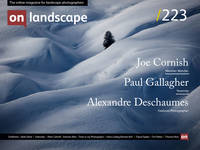Sandblasted and Captivation by Anthony Lamb

Thomas Peck
The real pleasure of photography is that it forces me to slow down and really look. That’s never easy in our rushed world, so a chance to stop, look and see is truly valuable.
In my last article (Huibo Hou & how a Witch’s Finger becomes Fine Art, On Landscape 216) we looked at how a hugely contrasty, chiaroscuro, emotionally drenched landscape image from the Faroe Isles exemplified the awesome Burkian sense of the Sublime. A fantastical, grab you by the eyeballs and squeeze image, that just exuded black & white drama. So, as a complete contrast, I thought it would be interesting to look at something from the other end of the spectrum – the equally beautiful, but quiet, meditative and minimalistic images by Anthony Lamb of the trees in the Dubai desert, from his Desert Portraits series.
There is a stillness to these images which is quite bewitching. A feeling of tranquillity and harmony, of peacefulness and austere simplicity. The lighting is very delicate and evanescent - there is a sort of fragility to the mood of the images. I must admit, this is not how I envisage the desert, and here is perhaps the first key to understanding the beauty of these pictures: They represent a very personal and unique interpretation of how the desert can look. Anthony describes his minimalist style in this portfolio as “pastel expressionism – the opportunity of escape into solitude”.
It’s fascinating to think for a moment about exactly how and why these images create this mood. I suggest there are four key elements to a minimalist image: simplicity, colour, strong composition and the powerful use of negative space. The first – simplicity – is perhaps the most obvious. We all know that for a minimalist image the author has to decide on the subject and strip away all non-essentials to that point beyond which it would start to lose impact. Here, Anthony is asking the viewer to look at the tree in Sandblasted and the tiny distant bush/tree in Captivation, underscored by two tiny patches of different coloured sand. All other potential focal points have been stripped away, there is nothing to tug the eye, and the other elements within the image play a secondary supporting role to those subjects.

